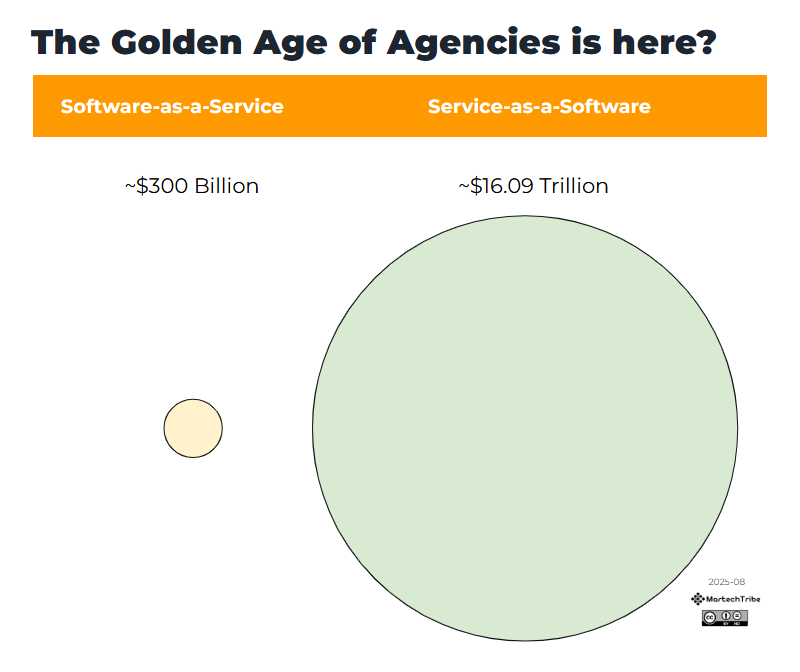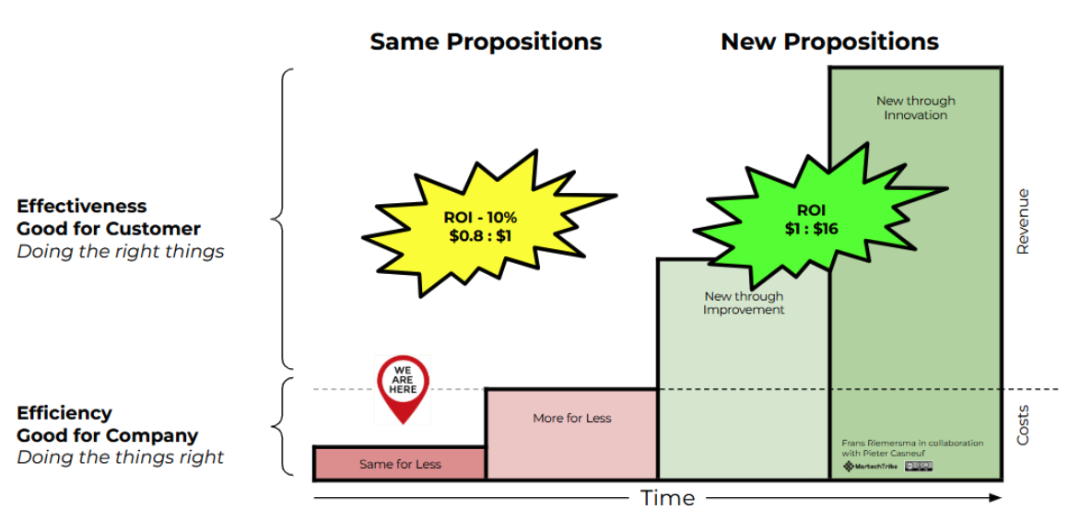
Marketing departments will soon manage their technology stack like eco-systems of connected apps. This finally brings them agility, efficiency, resiliency and more revenue.
Marketing technology automation is hot. The marketing technology landscape is growing fast. The number of solutions is increasing at breakneck speed. Over the last year the number of Marketing Technology vendors grew by 51%. An ocean of marketing tools is flooding the market.
Guy Marion describes how marketers are using Buffer to manage social channels, Pipedrive to track deals, Eventbrite to handle ticketing and Shopify to sell online. I have seen marketers using Trello to manage agile teams, Wrike to plan projects, Evernote to share campaign ideas, LinkedIn to fill the pipeline with B2B leads, Youtube to publish product video’s. And the list goes on.
“The lifecycle of marketing channels is accelerating. It’s good to understand that every successful channel is a dying channel.” — Peter van Sabben
Surfing the marketing apps tsunami
Marketing managers are horrified by this trend. They fear losing control. All they want is being presented with consolidated insights and reports. They fear that the ‘marketing app tsunami’ will only bring fragmentation and disintegration to their assumed coherent marketing enterprise software. It will be chaos. Mayhem. No wonder that marketing integration, or “how to leverage everything?” is their biggest marketing challenge these days.
Meanwhile, marketing staff is thrilled. Finally they can pick and choose their own tools in broad daylight; they don’t have keep their personal favorites under the radar anymore. Now they can happily insert new apps into their daily workflow, instead of shoehorning their agile workflows into enterprise software, handpicked by management. Marketing staff wants to be agile and react instantly to customer needs. Freely adding apps gives them the agility they need.
“Successful marketing is about iteration. Experimentation. As marketers, it’s our responsibility to build a process-driven foundation for constantly adapting and improving our ideas in order for them to consistently produce the results our organizations require. Agile Marketing.” – Jascha Kaykas-Wolff
Is the need for a myriad of marketing tools a new trend?
I believe not. For many, it is a long-cherished desire. Working with an array of tools is a long standing practice. The only difference is that the current app tsunami can no longer be ignored by management. It allows ‘the many’ to come out of the marketing tool closet and unashamedly flaunt their deepest preferences.
In the old days, I have come across many internal “black markets” inside numerous brands where marketers built their own homegrown, “quick and dirty” marketing automation solutions, secretly financed with campaign budget.
I remember one of my projects for a global technology company where we had consolidated 8 content management systems into one. Officially, we did not save one dollar, but the unofficial savings ran in the millions.
The natural state of internal marketing environments is to work with an array of software tools. That was the obvious outcome of the dozens of marketing technology quick scans we did for many multinationals. In the Marketing Operations departments alone we found 20 different tools or apps. Just have a look at an example of our marketing technology mapping canvas.
And there are many more marketing automation tools to add, like acquisition, email, retention or analytics, which are being used by other parts of the marketing department. We found that these Marketing stacks consist of 18 tools on average.
That brings the total number of apps and tools used to around 40+ for a mid-sized marketing team of, say, 75-100 people. How many tools does your team use?
This considerable number will only grow. The reason is that the barrier to adopt a new tool or app is getting lower and lower. Apps will sneak around the company backdoor.
These days marketers go online and purchase affordable apps so they can reach their goals as a team. If they can bypass bureaucracy, they will. Once the trial period is over and the team is on board, they replace the personal credit card details with the company’s details.
The result of the increasing number of apps inside marketing environments is dispersed data, needed to create the necessary reports for management. Much to the horror of marketing managers. But that fear is no longer justified.
Marketing tool moonshiners cannot be beaten. You’d better facilitate them well, so you can quite easily make them work for you rather than against you. Use the organizational Qi energy in your favor.
Integrate your marketing technology stack with… yet more apps
Apps like Zapier and IFTTT will change the dynamics of managing marketing technology stacks. From now on marketing technology stacks will behave like ecosystems.
No more vendor selections. No more dreading pitches. No more painful implementation projects. No more rigid enterprise platforms imposed by your management. No more “not invented here” resistance from your staff.
Instead, teams will select apps what they like most. Stacks will differ per team, Business Unit or region. Who cares? All can be integrated, whenever needed. A set of apps can be even used for the duration of a marketing plan, program, event, campaign or sprint.
Every marketing team, even within the same company, can piece together their own marketing use cases. They naturally create workflows by selecting apps and connecting them though other API-like apps such as Zapier and IFTTT. Here are just a few combinations of apps Zapier can connect seamlessly.
- Add new Eventbrite attendees to Salesforce as leads
- Share Mailchimp campaigns on your LinkedIn Profile
- Post new Trello activity to a Slack channel
- Post Evernote notes on WordPress
- Buffer WordPress posts
By using Klipfolio or Kibana marketing managers will be able to draw their reports for management. With the Boardview.io app, you keep track on the delivery of the strategic, tactical and operational goals across the tools.
This approach will gain ground in the next years to become an accepted practice. In the market the changing mindset already felt. And so are the first collisions with the old habits.
The management of a large bank recently decided to conduct an all-encompassing agile organization make over. They are currently transitioning from using traditional organizational charts to relying on agile tribes & squads.
In its wake the same management selected an agile management tool and told ‘top down’ that all tribes and squads had to work with it. According to an agile trainer, responsible for the transition to agile, this led to resistance.
Oops, management forgot to apply the agile principles used for the organizational transition, to the technology stack.
Benefits of an integrated marketing technology stack
A new model to manage functionality has emerged in IT departments. It is called microservices. It is an approach where large applications are broken down into minuscule, autonomous, near atomic pieces, loosely coupled and combined.
The concept of microservices is used by Google, Amazon.com and Facebook. They have been running microservices for over a decade now. Every time you search for a term on Google, it uses over 70 microservices before it returns the result.
The interesting thing about the microservices is that the same benefits apply to integrated marketing technology stacks. Basically, a simple marketing app is enterprise software broken down to a small set of functionality. You can stack functionalities and build anything you want. Just like Lego.
If we go through the 4 benefits of microservices you will see that only minimal tweaks are needed (compare here Matt Miller’s list) to illustrate the benefits of an integrated marketing technology stack.
1. Agility. By connecting an array of apps via validated API’s, marketing teams can easily integrate and exchange relevant marketing data and quickly create meaningful reports. No complex change management processes. No complex and often failing IT integration projects needed.
2. Efficiency. Using integrated apps results in far more efficient use of the infrastructure. Teams will only select apps that serve their purpose best, resulting in high adoption rates that would make enterprise software companies jealous. No expensive and often failing change management and consultancy projects needed.
3. Resiliency. The dispersion of apps across teams takes away the single point of failure of a central platform. The result is a marketing stack that performs much better with very limited downtime and can scale seamlessly on demand.
4. Revenue. Faster iteration and less downtime add up to more revenue.




